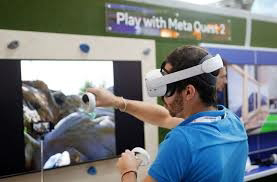Creating virtual reality (VR) videos involves capturing and editing footage that can be experienced in a fully immersive 3D environment. Here is a step-by-step guide on how to create VR videos:
1. Planning: Start by determining the concept and purpose of your VR video. Decide what story or experience you want to convey to your audience. Plan the scenes, camera positions, and movements to ensure a smooth and captivating VR experience.
2. Equipment: You will need specialized equipment to capture high-quality VR footage. Consider using a 360-degree camera rig or a virtual reality capture setup, which typically consists of multiple cameras placed in a specific configuration. Ensure your cameras can capture high-resolution video and have stable synchronization.
3. Filming: Set up your camera rig or capture setup in the desired location. Make sure to follow the camera manufacturer's guidelines while setting up the equipment. Position the cameras strategically to capture the entire 360-degree field of view. Use a tripod or stabilization tools to minimize camera movement and ensure stable footage.
4. Capturing: Start recording the footage while considering the scene composition and camera movements. Experiment with different angles and perspectives to enhance the immersive experience. Remember, you cannot control the viewer's focus point in VR, so make sure that important details are present in the entire 360-degree field of view.
5. Editing: After capturing the footage, import it into a VR video editing software or a 360-degree video editing software. Many popular software options include Adobe Premiere Pro, Final Cut Pro, or GoPro VR Player. These tools allow you to stitch and synchronize multiple camera angles to create a seamless 360-degree VR video.
6. Stitching: In the editing software, use the stitching feature to combine the footage from all the cameras into a single 360-degree video. This process aligns the different camera angles, removes any visible seams or distortions, and creates a cohesive VR experience. Ensure a smooth transition between the camera angles to avoid jarring visual changes.
7. Post-processing: Enhance the visuals of your VR video by adjusting colors, contrast, saturation, and other post-processing effects. Use the editing software's tools to improve the overall clarity and crispness of your footage. You can also add text, graphics, or other overlays to provide additional information or branding.
8. Exporting and Distribution: When you're satisfied with the final edit, export the video in a compatible format for VR distribution. Common formats include MP4 or MKV with H.264 or H.265 codecs. Consider uploading your VR video to popular platforms like YouTube VR, Facebook 360, or Vimeo 360 for easy access and wider distribution.
Remember to test your VR video on different VR headsets to ensure compatibility and smooth playback. Creating VR videos is an evolving field, so it's important to stay updated with the latest tools, techniques, and best practices to create the most immersive experiences for your audience.


No comments:
Post a Comment